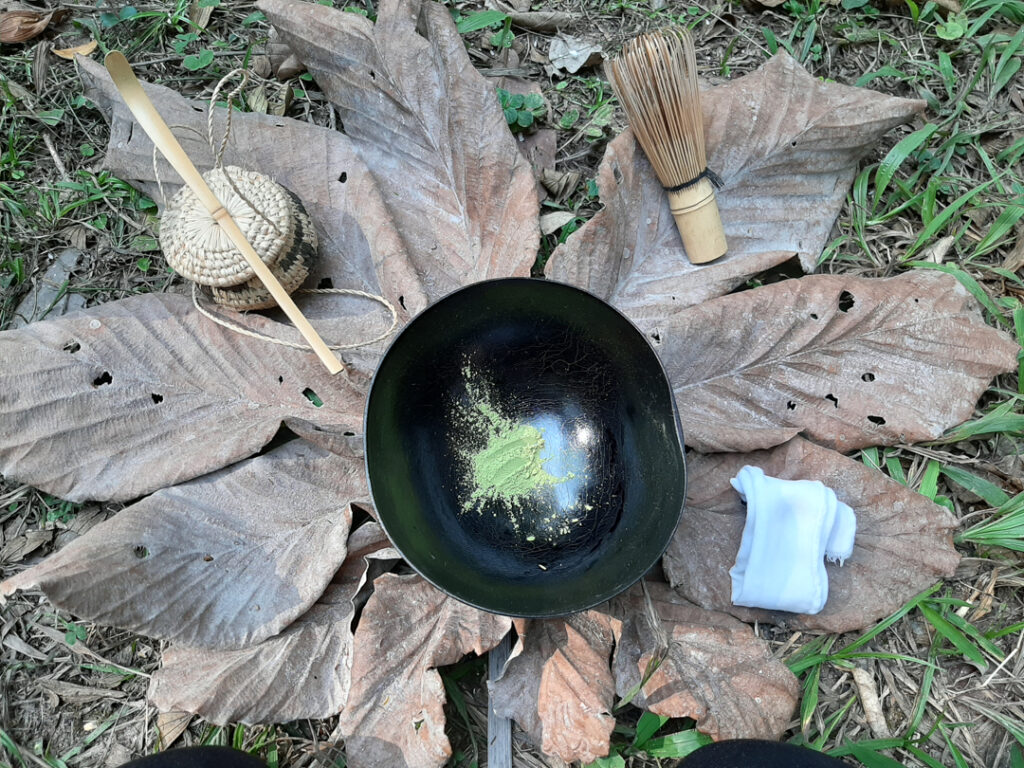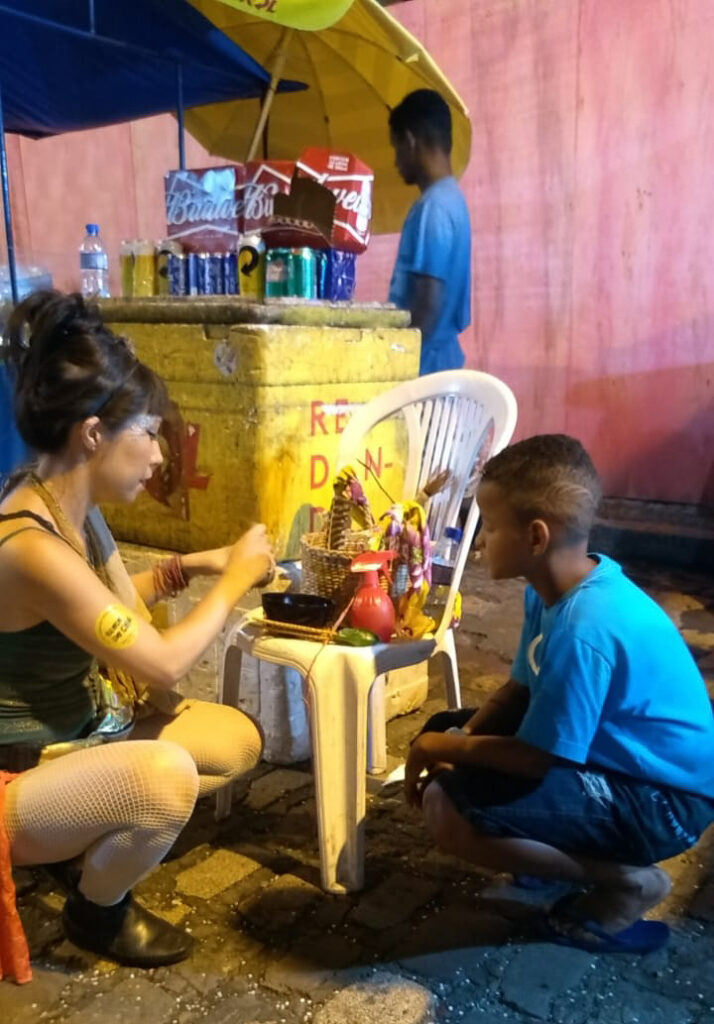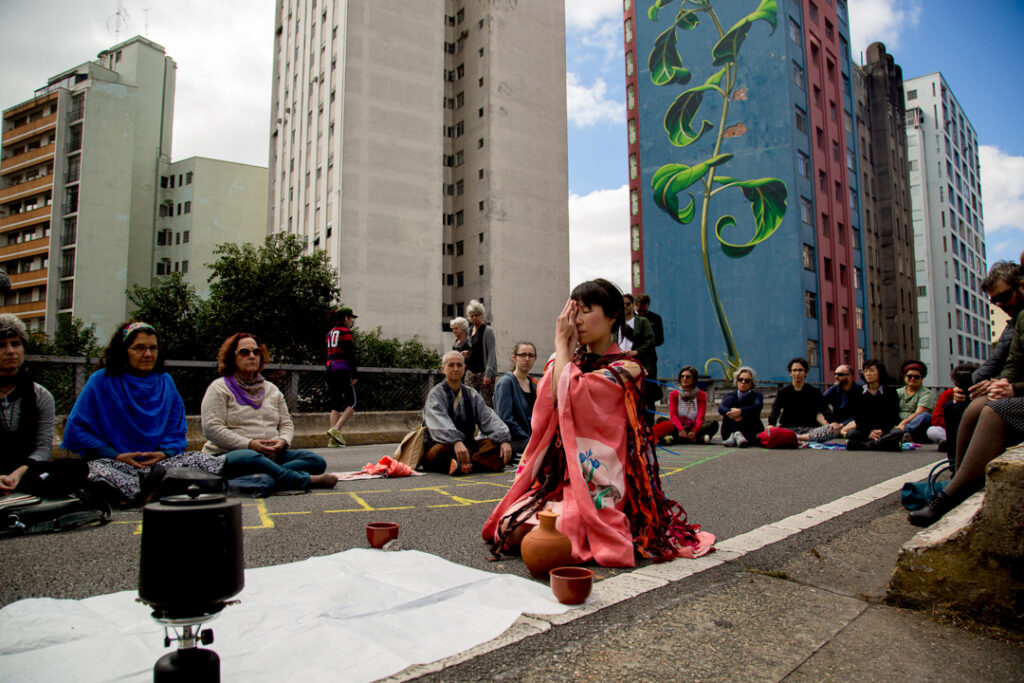
Erika Kobayashi performing a tea ceremony at Minhocão (literally, Great Worm, an elevated highway in downtown São Paulo, Brazil) on August 6th in solidarity with the victims of the Hiroshima atomic bombing. She wears a kimono received as a gift and Mona Caron’s mural is “improvised” as a chabana (tea flowers). Photo by Jennifer Glass, 2017.
Liliana Morais interviews Brazilian performer Erika Kobayashi about how she updates the Japanese tea ceremony to suit the pulse of life in Brazil.
In this interview, Erika Kobayashi reflects on the entanglements between tea ceremony and dance, tea harvesting and serving, tradition and transgression, drawing on her decade-long tea ceremony practice and lived experience as a Japanese-heritage woman in Brazil. In the complex web that weaves history and aesthetics, politics and ancestry, taste appears as a sense connecting people, places, objects, flavors, inspirations, expressions, and displacements between and beyond Brazil and Japan.
Erika Kobayashi is a Brazilian performer, researcher, and tea practitioner since 2011. Her artistic research merges the practice of presence in traditional Japanese arts, somatic body approaches, time listening, and an exploration of the body connection to places, people, and writing. She has performed tea ceremonies in public spaces in Brazil, Portugal, France, Iceland, and Australia. Since 2019, she has occupied backyards, parks, squares, forests, and tea plantations with “tea in performance” in an urge to return to the essence of an ancestral practice that expresses and deepens the communion between nature and human beings. For the last four years, she has partaken in the harvesting and processing of green tea in an organic plantation in Northern Portugal, investigating and documenting movements performed in tea picking and processing, fine-tuning the sensitivity of aromas and textures in different stages, and seeking to express the essence of Camellia sinensis through an aesthetic approach informed by the tea ceremony.
✿ Tell me about your first encounter with tea.
The first time I heard about the tea ceremony was in 1997, when I had just started working as a journalist. I interviewed a tea master for the newspaper I was working, who presented a very simple ceremony called bontemae (盆手前) [a simplified version of the Japanese tea ceremony performed in a tray on a table]. And one thing he said about the tea ceremony lingered in my memory: everything is done in the most sublime manner because, in case those people never meet again, that moment will remain in their hearts forever.
I came to understand this on a deeper, personal level in 2003, when I took a trip to Paris. A day before boarding the plane back to Brazil, I lived through something that I realized would never happen in my life again. And I thought: this is the essence of the tea ceremony. I remember being in the kitchen, with a sachet tea served in a bowl, which is how the French drink it, and I knew that I would never see that person again, that that moment, that encounter was unique, the ichigo ichie (一合一会)1. Ichigo ichie 一合一会is a Japanese concept that can be translated as “one moment, one encounter” and which is at the center of the tea ceremony as developed by Murata Jukô, Sen-no-Rikyu, and others in the 15th and 16th centuries. , which my tea ceremony teacher, Adam Wojcinski, translates as yolo (you only live once).
In 2007 I went to live in Paris and bought a piece of furniture that was like a chest where I kept my photos, diaries, two ceramic pieces that I had brought from Brazil, an iron teapot that Japanese immigrants in Brazil often use at home, a package of bancha tea and a wooden spoon that I bought in a Japanese store in Île Saint-Louis, which I still use today to measure the quantity of tea leaves to put in the teapot. People would come to my house, and I would ask them “do you want some tea?” and open the chest, choose a piece of pottery, choose a tea, and heat water in the electric kettle. But I strived to create a unique moment for that encounter.
That was the beginning of the story in which tea became an essential part of my life, something that I offered people, that accompanied these various encounters. I also started to receive teas as gifts: loose-leaf tea, blended tea, tea from the French brand Mariage Fréres… People travelled and gave me gifts of tea. When I came back to Brazil, I felt connected to Paris by drinking tea. Then I started to write a blog, Cerimônia do Chá, and in 2011 I enrolled in a tea ceremony class and never stopped.
It has been twelve years since I started studying chanoyu (茶の湯)2. Japanese tea ceremony is known in Japanese as both chanoyu 茶の湯 (literally, tea and hot water) and chadô, recently pronounced sadô) 茶道 (the way of the tea). While the former emphasizes the manner and act of serving tea for guests to enjoy, the later stresses its role as a practice of personal and spiritual development that can lead to Enlightenment. This later connotation is present in the suffix do 道 (way or path), present in other so-called “arts of self-cultivation” such as shodo 書道 (literally, the way of the brush) or kado 華道 (the way of the flower), which are connected to the Taoist and Zen traditions. . I like to say “chanoyu” because the word reminds us of the essence, which is tea and hot water. Yu 湯 carries the meaning of a certain relaxation, of a “pastime”, of enjoying something. When we say “chanoyu” we are emphasizing this essence, that it is a plant and hot water, and we allow ourselves to bring this sensory component, of the body. When we think of sadô 茶道, we are talking about the technique of teaching, of learning, of a system of transmission, and all of this is very important because otherwise, this knowledge would not have arrived here in Brazil 400 years later. But I always like to go back to the essence. When we get lost at any moment, it is always good to go back to the essence.
✿ You mentioned ichigo ichie, which alludes to this idea of ritualizing an encounter, to the fact that each moment provides an opportunity for an encounter, which will be unique depending on the people involved, the objects used, the tea drank, the thoughts and worries of the day… In what ways are chance or accident part of the tea ceremony?
One element is the question of composition. I will offer a tea and choose what I want to communicate through this tea, what is the poetic inspiration behind the choice of certain objects, which will communicate this feeling. And since I wanted to take the tea outside of the tearoom, sometimes this interferes with the choice of place as well. The place is not just a setting. It is what it will tell you, who are the people passing by, the exchanges that it allows, or its meaning. Everything is an evocation: an object, the sweet accompanying the tea, the ingredients, the poetic inspiration…. In this sense, it is a ritual, and we are evoking forces. Moreover, from the moment I am in a place that is open, that is not a closed room, where people pass by, where a leaf from a tree falls, a bird sings, and sometimes, in the interval between one movement and the other, a car passes by… This tearing sound creates a new meaning. And then we welcome it, we compose it, we choose what position to take in relation to what is presented.
If everything is structured according to tea ceremony standards yet permeable it is possible to incorporate various elements. That is why it is important to be very open to being permeated, to practice active listening, and then choose to take things in or not.
My “tea in performance” has several elements of a traditional ceremony. The whole philosophy is there, the movements, the gestures… But there are also artistic and poetic displacements. Anyone with an open heart to have an experience is welcome. When we do a tea ceremony, we start by purifying the objects, so that the host purifies him or herself and make the tea with a pure heart. So we are in this openness, in this availability to live an experience. This is the invitation.
✿ The question of opportunity, of being open to chance also manifests itself in the objects and ingredients that you incorporate into your performance.
It has a little to do with chance and a little to do with choice. What is called toriawase (取合わせ) 3.Toriawase 取り合わせ literally, assortment or combination, refers to careful and mindful act of selecting and combing the objects that will take part in the tea ceremony., which is how you go about making that combination, brings a unique narrative to each situation. That’s why they say that what will happen is a “once in a lifetime” encounter. But it also has a side of improvisation.
Here in Brazil, I can study in a tea school that has all the objects I need for my practice there. But from the moment I bring my practice home, I will have to make some adaptations. I came to discover that this is an aesthetic strategy called mitate (見立)4.Mitate 見立てis an aesthetic strategy often used in Japanese art, especially ukiyo-, which can be translated as “seeing with one’s own eyes” or “seeing anew”. It is reflected, for example, in the use of certain words, images, or objects in new and unexpected ways.. Being in Brazil, I also do it out of necessity, because I don’t always have access to all Japanese objects. I think I became good at mitate because this creativity was required of me. Interestingly, I have never commissioned any objects. They are all things that, by chance, have come my way.
- Erika Kobayashi at the World Tea Gathering in Reykjavík, Iceland. “I wanted to take some things that were somehow representative of Brazil, not only of cultures but of the land, so I went to find basketry objects and tacacá gourds”. Photo by Ryo Yamauchi, 2014.
- Bontemae by Erika Kobayashi in São Lourenço da Serra, Brazil. Basket and tacacá gourd are used as mitate. Mate is used in place of matcha green tea and embaúba leaf is used a stray. Photo by the artist, 2020.
Also, I won’t always have the Japanese ingredients to make the food that accompanies the tea, so I will create with what I have on hand, incorporating experiments I do at home in my public tea ceremonies. For example, if it is a hot day and I have coconut water at home, I can make a cold matcha with coconut water.

Yôkan with juçara from Vale do Ribeira, during the opening of the Rota do Chá tea tour. Photo by Cláudio Brisighello, 2019.
When I served the farmers in Registro5.Region in São Paulo state, Brazil, known for its Japanese immigrant community that has historically dedicated itself to agriculture, especially the cultivation of Camellia sinensis introduced there by Japanese immigrant and tea technician Torazo Okamoto., I mixed juçara, which is a kind of açaí, with azuki paste to make a yôkan sweet, because I wanted to serve the farmer with something that was from his own land. I also burned another farmer’s tea leaf in the place of incense. All this reinforced my connection with the producers of Registro, with the things that come from the land of Ribeira Valley.
This comes very naturally to me because it is my way of living my life. I don’t separate the study of the tea ceremony and the rest of life. It all permeates my day-to-day life, with the things I live, with the references I carry. There is not much separation, so it is very natural that things contaminate each other, in a good way.
✿ What is the role of transgression in tea ceremony?
From the first day that I started studying tea ceremony, I found everything so incredible that I asked myself how is it possible that this doesn’t go outside of this space? How is it possible for this experience to be accessible only to a certain community of people, who come here and know this series of codes? Why can’t I take the tea outside the tearoom?
Therefore, I started inputting my way of doing things, never disconnected from the essence. All of the things I do in my “tea in performance” are anchored in aesthetic and philosophical precepts, in ancient texts about tea ceremony, which I have studied. Mitate is something that anchors my practice a lot and it is possible to do mitate outside the tearoom. I know what my base is and from that base I both welcome what comes from outside, the “happening” in the philosophical sense, and create my own displacements. It is something that I feel is so strong that it overflows.
When I was in Portugal, I didn’t have the traditional Japanese objects, but I found a Portuguese brazier that was used to heat the room, which I repurposed as kama. I also found a ceramic vase to water plants that I ended up using in the place of the mizusashi. I took the act of watering plants along with this fresh water. So, I am very conscious of what each object carries, of each choice I make. Sometimes the choice comes by chance, and it adds another layer of meaning.

Tea ceremony with repurposed Portuguese objects during the ten-year celebration of Chá Camélia in Fornelo, Portugal. Photo by Jorge Simão, released by Chá Camélia, 2021.
For tradition to survive, it must be updated. This doesn’t mean denying it, questioning it, or wanting to impress. It is to allow it to have its own pulse of life, to be open to the pulse of life. As I was born in Brazil, I will carry things that a person born in Japan will not carry. Ever since I was a little girl, when a relative died, I would go to a Buddhist ceremony. So, my first reference to the tea ceremony is the Buddhist mass: the way the monk walks, the way he holds the objects, how he makes the offerings on the altar… I have this in my memory.
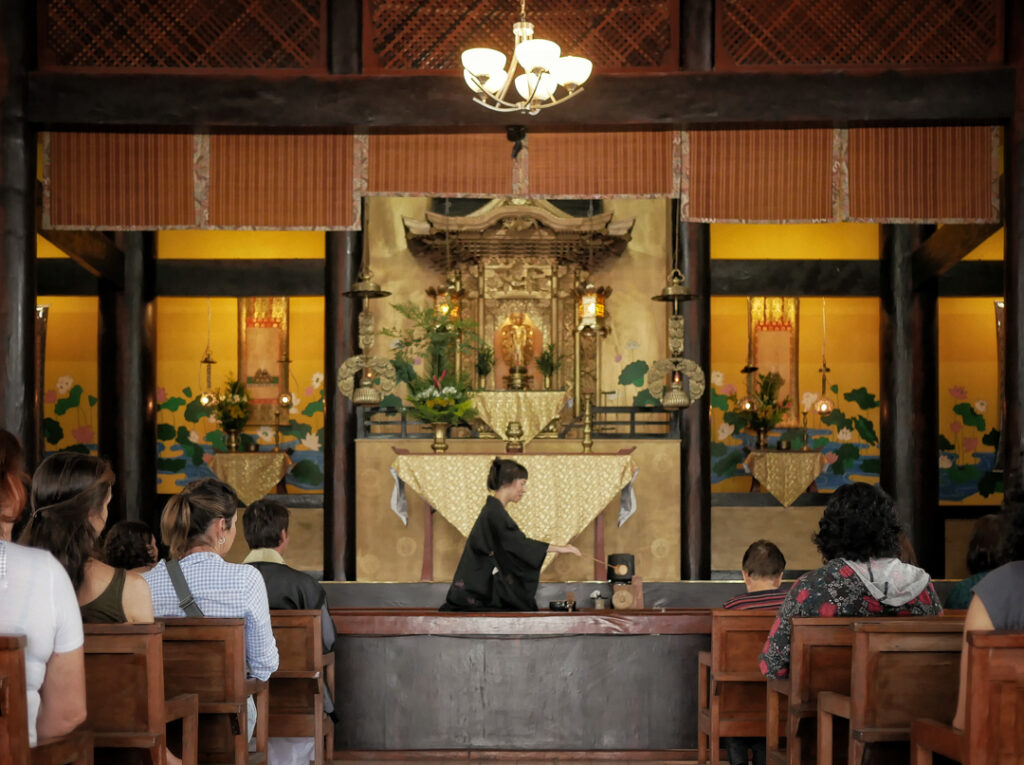
Tea ceremony in Hompa Honganji Temple in Chácara Inglesa, São Paulo, during the opening of the Rota do Chá tea tour in Registro. Photo by Cláudio Brisighello, 2019.
Then, throughout my life, I have had experiences with Umbanda and with indigenous rituals—there’s a lot of syncretism in Brazil, and the practices of the original peoples are accessible if you are open to them. I learnt from some indigenous traditions to consider a beverage not only as something you drink, but also as a sacred plant that has properties that will amplify your consciousness in some ways. And Camellia sinensis has substances that increase focus, concentration, that give a certain relaxation. No wonder monks drank tea during long meditation sessions, and that’s how tea got to Japan in the twelfth century. Looking at the drink in this way also allows an activation of the body in me, and somehow suggests this to the people who attend the ceremony even if I don’t speak, even if I don’t communicate through words, because I am relating to the beverage in this way. And all this exists in “tea in performance”. Because it has my experiences.
✿ Besides the performance of the tea ceremony, you have a relationship with the production of the tea leaf itself. Tell me a little about this.
Here in Brazil, I got to know the producers in the Vale do Ribeira, a region that has a history of Japanese immigration and many of these families dedicated themselves to the cultivation of tea until the 1990s. Today there are only three families left that I had the opportunity to get to know through the “Tea Route,” which is a route that Yuri Hayashi organizes for the students of the Embahú Tea School. And she invited me to open the routes with a tea ceremony for the producers. This was the first opportunity I had to get to know the tea plant and the history of the producers here in Vale do Ribeira.
And when I lived in Portugal between 2014 and 2015, I met Nina Gruntkowski, a person who started to grow Camellia sinensis in the backyard of her house in Porto, who already imported Japanese teas to Portugal through her brand Chá Camélia. I met her by chance at a pottery exhibition where she was serving tea. The North of Portugal is known for the flowering camellia trees, which are from the same family as the tea plant. So when I returned to Portugal in 2018, Nina invited me to visit her tea plantation that she had taken from the backyard of her house in Porto to a farm in Fornelo. The following year I returned as a volunteer for the first commercial harvest and in 2021 I stayed there for six months. I never stayed in a place where there was so much tea.
I was living there, surrounded by the plant at all stages. So I could experience the plant, the cycle of the plant, the varieties of Camellia sinensis that exist there, as well as the harvest and the processing of green tea, which requires a lot of presence, attention, and active listening. And this practice of active listening happens through the smell at different stages of processing, through the sound of the leaf hitting the pan when it is getting drier, and of course through taste… The processing of tea demands a lot of presence. One has to be attentive at all times.
In 2021 I partook in the summer harvest, and in 2022 I was there for the three harvests: the first leaves (for premium green tea), spring, and summer. And we see how the leaves change according to the season, the climate, and this gives us that experience of touch, smell, and taste. So it is from this sensitive and sensory listening that we improve for the next day and the next year’s harvest. Green tea has this advantage: you harvest it, process it, and you can drink it the same day. The taste won’t be too developed, but it already gives us clues as to what it will be, what flavor it will carry, and this helps us to improve for the next day. And the tea will tell you how it wants to be handled.
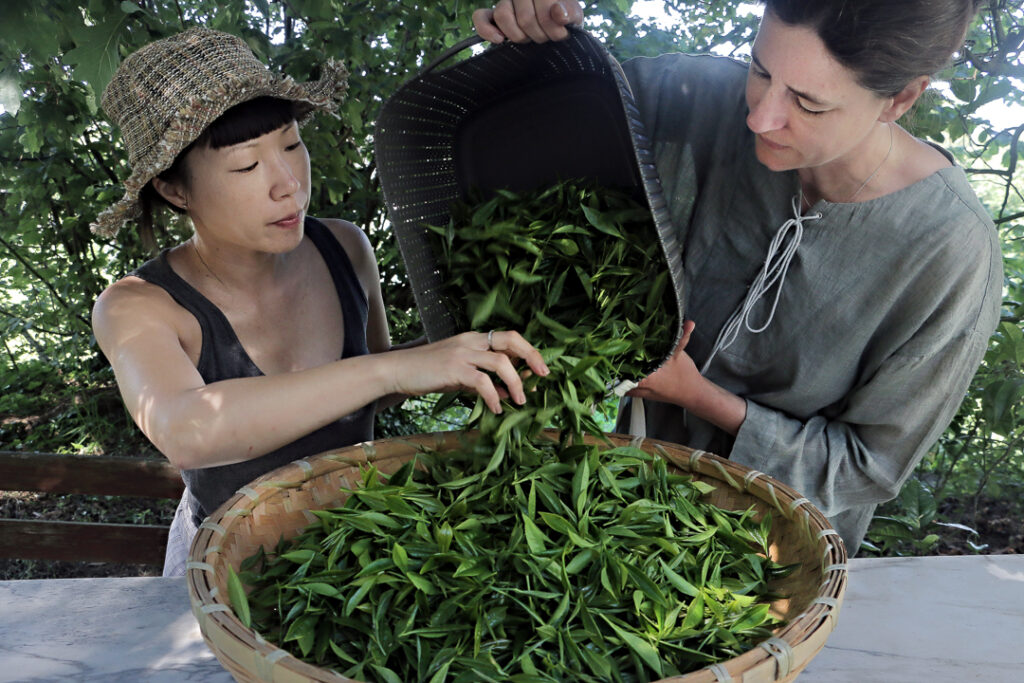
Tea picking and processing for Chá Camélia in the North of Portugal with Nina Gruntkowski. Photo by Conceição Ferreiroa, release by Chá Camélia, 2019.
✿ In what ways did the encounter with tea provide a connection to your ancestry and your family history?
It is a two-way process. Ancestry helps me understand tea, and tea helps me understand ancestry. When I put on a kimono, I will have an interpretation of that kimono in feeling that may be different from other people, because I was born in Brazil. The kimono is a garment that binds me in an absurd way. Especially in the beginning, I felt suffocated with the kimono on. I couldn’t walk properly. I tore many kimonos because I didn’t know how to sit and how to stand up like Japanese women do when they wear a kimono. But the kimono teaches me to draw my movements more precisely and beautifully. It is the same story with the objects: you need to have the traditional objects, the traditional kimono, in order to know how to move, carry the objects, learn the posture and the gestures, and from there to move to other places.
So, the kimono suffocates me and reveals me. As I went on to somatic practices, I learned that I can have mobility with a kimono on. And this, at the most unconscious level of the body, of the cells, of the fasciae, of the skin, of everything, has the power of shifting ancestral memories that each body carries, and I carry some that are related to the fact that my family came from Japan two generations ago.
The tea helps me explain things that I don’t understand. It also helps me remember ways of doing things without being taught why I should do some things in certain ways. I know how to pick and handle some objects without anybody having taught me the formal way to do it. Other things I had to be trained on because I was a complete disaster at them. So, all the time I am confronted with this double origin. Although I was raised as a Brazilian, speaking Portuguese, there are things I do in the tea ceremony, when I’m cooking or when taking care of the mizuya, that now I understand why my mother used to do in a specific way. Because she was repeating things that were done by her mother, her grandmother, her great-grandmother, and so on.
Furthermore, for being a woman with Asian traits serving tea, there is the danger of people interpreting it while resorting to stereotypes, such as that of submission. No matter how I am dressed, people are going to have the reading of my artwork as delicate; not that tea is not or that it is an offence. But it’s important that I put myself out there, in the sense that I can be other things besides this preconceived, preconstructed image. So my tea is political as well.
And in relation to harvesting, I see that there is a form of manipulation, of gestures, that I do in a certain way, that carry a repertoire of what I have experienced, like martial arts of Japanese origin, in which I am also trained. Right now, I am working on collecting and documenting an inventory of gestures used in tea harvesting and processing, which will probably be part of my next performance. This also puts me in contact with this body. Because if I had another arm length, leg length, torso length, another height, I would be doing these gestures in a different way. And all that is there. Everything is there all the time, in everything we practice, in everything we do. What varies is how we fine-tune that perception and how it manifests itself.
Talking to people of Japanese origin who are born in Brazil like me, I realized that there is a place for the unspoken, a way of communicating that comes from this ancestry, that I don’t need to put into words. It is even difficult to explain. But if we are living a situation, we will know what it is. And it is not magic, it is not supernatural, it is not mystical. It is another training of sensibility. A sensibility that every human being is capable of, but that in some cultures, certain elements will be more latent.
I don’t speak Japanese; I only know a few words and phrases that we use at home or that my grandmother used to say. Nobody ever needed to explain to me what kokoro means. I created a feeling and a meaning the way my father used it in the middle of a sentence in Portuguese. And for me, this is a precious legacy I keep in my heart. When I read about kokoro ire (心入れ) [care, consideration, or thoughtfulness] in tea texts, it is something that I can feel more than I can explain.
✿ You spoke about the issue of tradition as a repetition of gestures, practices, and ways of relating to the world, which alludes to the question of technique. When I think about technique, which is central to these arts of self-cultivation like the tea ceremony, I think of handicrafts and making but also of the role of the body and of the encounter between these different “bodies”, human and non-human, that makers must listen to and work with. Do you see any analogies between what you do and what craftspeople do?
Being on the tea plantation brought me a greater awareness of this issue of listening, of making and of craft, because it has to do with the practice (o fazer) of the farmer. It is not you who determines the harvest, the production. It is the plant, the climatic conditions, etc. Working on the plantation helps me improve the practice of listening that I do in my performance, in the choice of objects, when talking to people, and so on. It is important that I have the technique because it gives me security, it serves as a base. This applies to the work of the farmer, the craftsman, and the performer.
I see the artisan as the facilitator of a process. He or she will evaluate what is there at that moment and, with his or her knowledge, sensibility, or expression, bring it to life. When harvesting, I ask “with all of the tea that I have today, how can I facilitate it to express its best flavor?”. In that performance, I can only have a few very well-built bases. The rest is just letting it happen. And the more we let it happen, the more enjoyable it is. This will teach us and give us the body to welcome it the next time, what each situation asks for. So, is the artisan also a performer?
✿ Speaking of performance, how did you bring dance to tea or bring tea to dance?
Basically, I got into dance because of tea. Since I wanted to take the tea out into the street, I felt that I needed to have a body to support it. That’s why this relationship between tea and performance happened, and that’s why I went into dance. And in the somatic approach, we also learn through experience, we study movements, patterns, and systems through experience beyond all the theoretical knowledge. I became very attentive to these perceptions: how does my body perceive the systems, the patterns of movement? So my body was being trained in this perception of and through the senses. How do I perceive? How do I process, integrate, understand, and give flow?
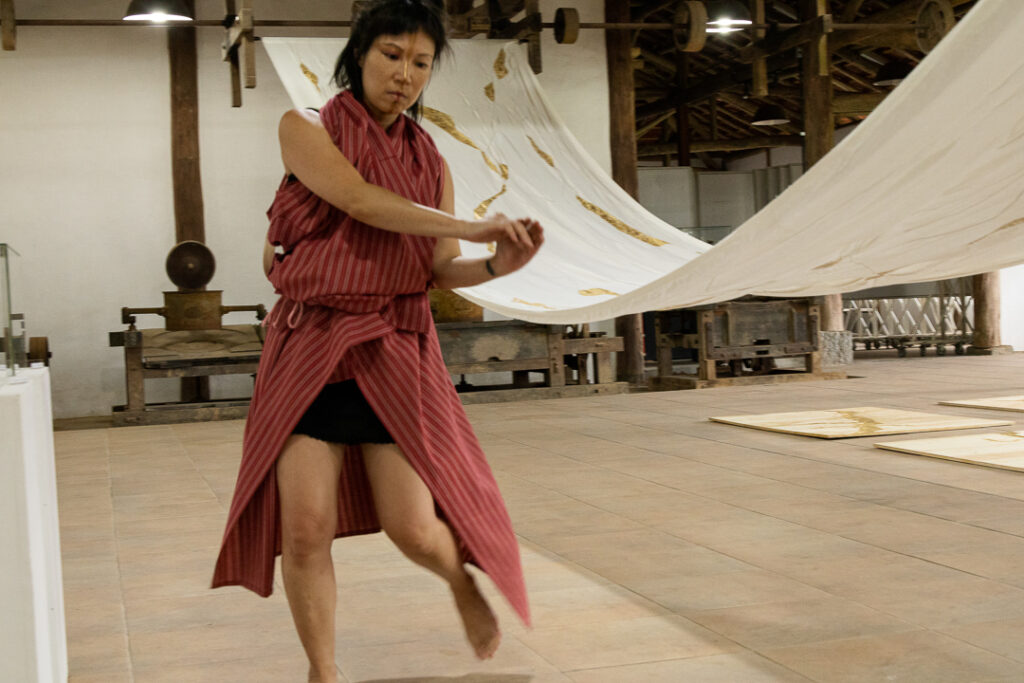
Confluência performance in Casarão do Chá (a small former tea factory established by a Japanese immigrant in the 1940s) in Mogi das Cruzes, Brazil, in the context of Brazilian visual artist’s Juliana Matsumura’s exhibition. Photo by Antonio Carlos Cardoso, 2022.
That’s a little of what I carry. I also did martial arts and yoga, two practices that teach and require body and mind presence, in which we move with our breath. I never had classical dance training; I guess I’m very open to letting the body express movements and use this as a source of creation. So there comes a time when we no longer know what feeds what. That is why I say that tea transverses all my practices. Because it goes through all these paths.
I no longer know where dance begins and where tea ends, what influences what, because it is all interwoven and entangled in the best possible way, in the sense that the practices are integrated: the spirituality, the political presence of this body, the culture, the aesthetics, the technical knowledge of the plantation, the dô, the philosophy… these are not separated. It is a complex weave that, due to study and technique, is expressed naturally, respecting the nature of the materials and the tea itself and its history.
Follow @cerimoniadocha

Follow @portugalbrasiljapao
Related stories
References
| ↑1 | Ichigo ichie 一合一会is a Japanese concept that can be translated as “one moment, one encounter” and which is at the center of the tea ceremony as developed by Murata Jukô, Sen-no-Rikyu, and others in the 15th and 16th centuries. |
|---|---|
| ↑2 | Japanese tea ceremony is known in Japanese as both chanoyu 茶の湯 (literally, tea and hot water) and chadô, recently pronounced sadô) 茶道 (the way of the tea). While the former emphasizes the manner and act of serving tea for guests to enjoy, the later stresses its role as a practice of personal and spiritual development that can lead to Enlightenment. This later connotation is present in the suffix do 道 (way or path), present in other so-called “arts of self-cultivation” such as shodo 書道 (literally, the way of the brush) or kado 華道 (the way of the flower), which are connected to the Taoist and Zen traditions. |
| ↑3 | Toriawase 取り合わせ literally, assortment or combination, refers to careful and mindful act of selecting and combing the objects that will take part in the tea ceremony. |
| ↑4 | Mitate 見立てis an aesthetic strategy often used in Japanese art, especially ukiyo-, which can be translated as “seeing with one’s own eyes” or “seeing anew”. It is reflected, for example, in the use of certain words, images, or objects in new and unexpected ways. |
| ↑5 | Region in São Paulo state, Brazil, known for its Japanese immigrant community that has historically dedicated itself to agriculture, especially the cultivation of Camellia sinensis introduced there by Japanese immigrant and tea technician Torazo Okamoto. |


